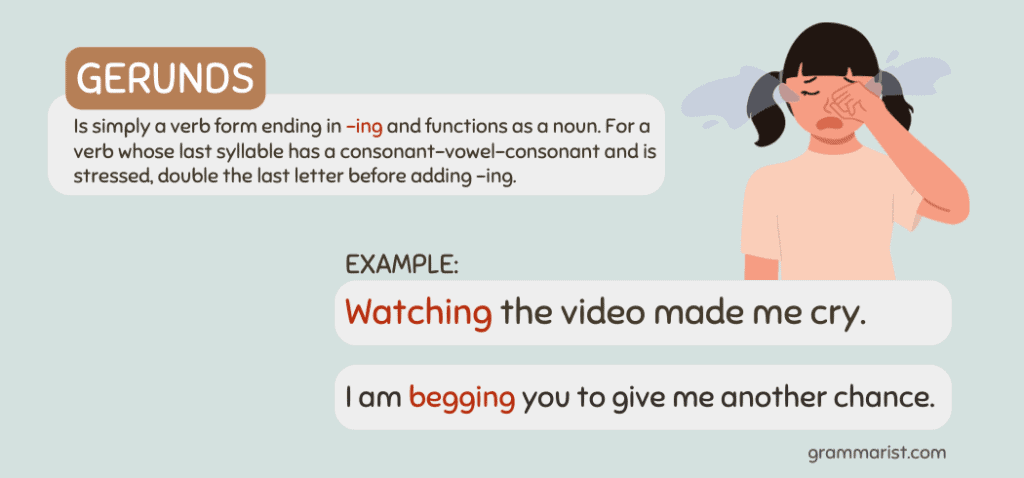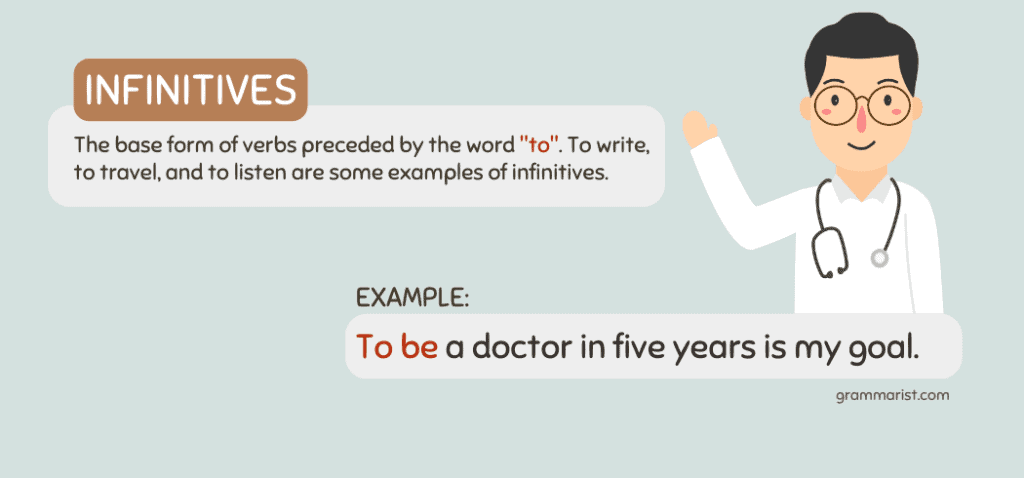Lots of verbs can function as gerunds or infinitives. But what are gerunds and infinitives? Good question, and one that I’m about to break down and explain for you.
Gerunds are formed when you add -ing to the verb, while an infinitive has to before the verb’s base form. Both verb complements may function as subjects and objects in a sentence.
Keep reading to learn the difference between gerunds and infinitives. I provided seven rules for their correct usage and a worksheet that will challenge your understanding of the topic.
What Are Gerunds?

In English grammar, a gerund is simply a verb form ending in -ing and functions as a noun. Walking, holding, and listening may seem like present participles, but they can also be gerunds that function as nouns. For example:
- Watching the video made me cry.
In this sentence, watching functions as a noun, specifically a subject. It is the gerund form of watch.
For a verb whose last syllable has a consonant-vowel-consonant and is stressed, make sure to double the last letter before adding -ing. Some examples include begging, beginning, and running.
What Are Infinitives?

An infinitive is the base form of verbs preceded by the word to. To write, to travel, and to listen are some examples of infinitives. Here’s an example of a sentence with an infinitive.
- The man in the office claims to be a doctor.
Common Verbs Followed by Gerunds
Here are some examples of verbs usually followed by gerunds.
- Abhor
- Advise
- Allow
- Anticipate
- Appreciate
- Avoid
- Can’t help
- Celebrate
- Confess
- Defend
- Delay
- Discuss
- Dislike
- Dread
- Endure
- Escape
- Feel like
- Feign
- Finish
- Forgive
- Mention
- Miss
- Permit
- Postpone
- Prevent
- Recollect
- Shirk
- Tolerate
- Urge
- Warrant
- Waste time
Common Verbs Followed by Infinitives
Here are some examples of verbs followed by infinitives.
- Arrange
- Ask
- Beg
- Care
- Chance
- Claim
- Come
- Consent
- Determine
- Elect
- Endeavor
- Expect
- Fail
- Guarantee
- Hesitate
- Hope
- Hurry
- Learn
- Manage
- Offer
- Prepare
- Prove
- Refuse
- Remain
- Say
- Shudder
- Strive
- Threaten
- Venture
- Wait
- Wish
- Yearn
The Seven Rules of Using Gerunds and Infinitives
How is using the gerund different from using the infinitive? Let’s take a look at the seven rules you should follow.
Rule 1: Gerunds and Infinitives Can Be Subjects of Sentences
A gerund or infinitive can be the subject of a sentence or the doer of the actions. Here are some infinitive and gerund examples.
- Cooking is my hobby.
- To be a doctor in five years is my goal.
In the first sentence, cooking is the subject because it answers what the topic is all about. In the second sentence, the subject is to be a doctor.
Gerunds as subjects are more common because they are suitable for both formal and casual writing. But infinitives as subjects are more poetic and formal.
Aside from acting as sentence subjects, gerunds and infinitives can also be the subjective complement of a sentence. A subjective complement follows a linking verb and complements the subject. Here are some sample sentences.
- The best part of the day is cooking dinner for my wife.
- The most important lesson for me is to be kind to everyone.
Cooking dinner for my wife is the subjective complement in the first sentence because it is preceded by the linking verb is and renames the subject, the best part of the day. In the second sentence, the subjective complement is to be kind to everyone.
Rule 2: Gerunds and Infinitives Can Both Be Used as Objects of a Sentence
The functions of gerunds and infinitives go beyond the subjects of sentences. A gerund and infinitive can also function as sentence objects or the receiver of the action verb. For example:
- Her sons like painting.
In this sentence, the gerund painting functions as the sentence’s direct object since it answers the question, “like what?”
Here is an example of an infinitive as a direct object.
- They decided to paint.
Remember that some transitive verbs require a gerund, while others require infinitives. The list of common verbs followed by gerunds and infinitives above will help you practice which one to use.
Below are more examples.
- I agreed to have shrimp for dinner.
- I decided not to go to Australia.
- I advise seeing the doctor after the medical examinations.
- I suggest writing your feelings.
Rule 3: Infinitives Should Be Used After adjectives
Typically, infinitives are used after several adjectives. For example:
- It’s easy to learn how to sew.
- It’s essential to communicate your feelings.
- It’s fantastic to have friends who always listen to your rants.
But the usage of infinitives stops when you want to turn the objects into subjects. For example:
- Learning how to sew is easy.
- Communicating your feelings is essential.
- Having friends who always listen to your rants is fantastic.
Another way to know that an adjective needs an infinitive after it is if the structure is too plus the adjective. For example:
- It’s too cold to go swimming.
- This book is too expensive to buy.
Rule 4: Infinitives Only Follow Certain Verbs Followed by Nouns or Pronouns Referring to an Individual
Some verbs followed by nouns or pronouns as indirect objects use infinitives instead of gerunds. For example:
- I ask you to try harder this semester.
- Who told Jane to wear a costume to the party?
Some verbs followed by nouns or pronouns referring to a person include expect, invite, order, remind, tell, urge, and warn.
Rule 5: Use Gerunds After Prepositions (with one exception)
One common rule of gerunds is that they may follow prepositions, including prepositions in phrasal verbs. For example:
- I love running before lifting weights so I can burn excess fats.
Here, the gerund lifting follows the preposition before. The whole prepositional phrase is before lifting weights.
But there is an exception that often involves confusing sentences. While but is known for being a coordinating conjunction, it can also act as a preposition meaning except.
When you use but in this sense, you need to use an infinitive instead of a gerund. For example:
- The teacher had no choice but to send the lessons by email.
Rule 6: Use Bare Infinitives After “Let,” “Make,” and Other Modal Verbs
Sometimes, we use infinitives without the word to. They are called bare infinitives, and you’ll find them after modal verbs like can, may, could, must, will, and more. For example:
- I might see you tomorrow.
- We should attend the event this Saturday.
- Elizabeth Bennett must visit Mr. Darcy after the dance.
You can also use the bare infinitive after the verbs let, make, and help. For example:
- She let him leave early.
- I made my mother buy me a necklace.
- Please help me understand this.
Rule 7: Some Verbs Can Use Either Gerund or Infinitive Form
A gerund or infinitive can follow some verbs without changing their meaning. For example:
- I prefer getting up early.
- I prefer to get up early.
Sentences With Gerunds
- Seeing my favorite artist’s new movie was the best part of my day.
- I enjoy checking my email every morning.
- Sheila avoided answering my questions.
- Answering 1-2 survey questions from the email newsletter will give you a chance to win tickets to the concert.
Sentences With Infinitives
- I don’t want to watch scary movies later.
- She only wants to play music videos, movie trailers, and fun, real-world videos of space.
- This pair of trousers is too big to wear.
- You’re smart enough to understand the documentary.
Let’s Review the Difference Between Infinitives and Gerunds
My guide has shown you the different gerund and infinitive rules with examples of sentences. Remember that gerunds always follow “-ing” verb forms, while an infinitive is the simplest verb form with the word to before it.
Remember the seven rules I taught you for the next time gerunds and infinitives challenge you. You can also practice conversation questions like “what do you look forward to this summer” to get used to using gerunds and infinitives.